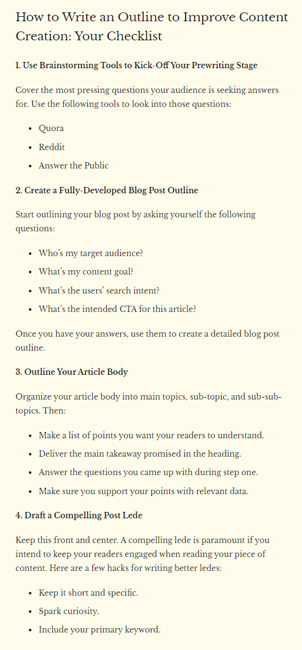Have you ever come across a lackluster article which you had to re-read to make sense of it?
Perhaps you’ve skimmed through a chaotic site wishing that the writer had better organized the posts?
It’s safe to say that an incomprehensible blog site may need to create a style guide. Or, for stress-free content creation, the owner should consider hiring a reputable writing service.
In any case, whether you consider yourself a blogging beginner or expert, using a tailor-made style guide will amp up your writing style and optimize your site.
Blog Style Guide Definition
A style guide is a document that guides the content production process for a blog, newsletter, scientific/educational paper, business, website, and so on.
Your blog should be consistent with your company’s character and culture to achieve optimal brand awareness. Therefore, a style manual will help amplify your site and, consequently, improve brand perception.
The guidelines provided in this style guide template, when incorporated into your posts, will exemplify your brand’s essence and authority by directing your blog’s:
- Content marketing
- Philosophy
- Language, voice, and tone
- Formatting (grammar and mechanics)
- SEO strategy
- Visuals and more
The icing on the cake? Well-written Search Engine Optimized (SEO) blogs will have visitors flocking to your site in no time — voila, organic traffic!
Why Blogs Need Style Guides

Blogs are powerful marketing tools and good lead and revenue generators for any B2B or B2C outfit.
Implementing a carefully crafted style guide will improve the quality of the information provided and the site’s overall aesthetic presentation. The enhanced user experience will, in turn, boost a site’s authority and brand awareness.
Don’t be overwhelmed by the list below; a simple style guide will suffice for most blogs.
10 Steps to Creating an Awesome Blog Style Guide
1. Know Your Market
First things first, ascertain who your target audience is by conducting marketing research. Establishing the personas of your readers will help refine your branding and marketing efforts.

2. Determine Your Blogging Tenets
This section of your guide helps you determine your blogging tenets insofar as your audience and goals are concerned.
When reflecting on your blogging philosophy, consider:
- What you want to achieve — e.g., becoming an influencer and inspiring trends, etc.
- Becoming an authority in your niche by creating long and detailed SEO articles that comply with Google E-A-T. (Expertise – Authority – Trust).
3. Specify Your Production Process
Whether you are a team of one or many, you need to have a production process. You might decide on a plan as simple as this one:
- Research hot topics in the XYZ industry. Alternatively, write on any subject that comes to mind and which energizes you.
- Unless you’re a certified expert, avoid Your Money or Your Life topics.
- Come up with a suitable title, summary, and keywords.
- When approved, prepare a detailed outline and seek input from someone trustworthy.
- Implement feedback and compile the first draft.
- Avoid plagiarism and provide attribution for any material sourced from external sources.
- Proofread and edit your work. You can accomplish this easily by reading your article aloud, using text to speech software, or in conjunction with an editor.

4. Define Your Brand’s Language, Voice, and Tone
Because the bulk of a normal post will be written text, essential points to consider include:
Language
What is the language spoken by most of your readers, as revealed in the market research above? Do they speak English, French, or vernacular, etc.?
If English, do they speak British English, American English, or localized dialects like Australian English?
Correct spelling and using the proper dictionary will distinguish the writing on your site from mediocre sites.
Voice and Tone
There are several things to consider when talking about voice and tone, and these are but two:
Some brands prefer being formal when considering the vocabulary to use in their blogging, while others choose to be informal.
For instance, a financial magazine like The Economist uses formal language, while hip hop magazine, The Source, incorporates slang in its writing.
A few brands make the most of both worlds by incorporating slang and urban words in their blogs. They may even use colorful swear words and crude verbiage in their writing as stylistic devices to create shock and awe.
Anyway, when considering the terminology to use in your writing, please be mindful and use correct grammar and simple vocabulary to ensure high readability and comprehension.
Consulting a dictionary after every other sentence is no fun at all. Make your posts scannable and a pleasure to read.
5. Select Your Formatting Guidelines
A style guide helps your site adhere to brand and editorial standards.
On planet Scribe — that fictitious place where all writers live and thrive — using an Oxford comma (or not) has led to many passionate arguments.
The list below is by no means exhaustive; it instead provides a snapshot of common writing mechanics and grammar elements.
Popular style guides such as the AP Stylebook and the Chicago Manual of Style are invaluable and are popular with journalists, authors, and corporations alike.
They will provide you with both basic and complex rules that you can incorporate into your style guide.
Abbreviations
Specify which words will be abbreviated and maintain the harmony of the preferred style.
First, spell out the statement, with the acrostic in parentheses, and then abbreviate in subsequent references.
For example, “Thank God it’s Friday,” when shortened, will either be TGIF or T.G.I.F.
Universally recognized acronyms such as URL and FAQ should remain abbreviated.
If you’re creating content for a technology newsletter, go for it — write Uniform Resource Locator (URL) and Frequently Asked Questions (FAQ).
It does, however, make for boring reading.
Capitalization
Discuss with your team or look at competing sites to ascertain whether title case or sentence case capitalization will work for your article.
Most corporate brands prefer sentence-style capitalization because it encourages lowercase use in all writing, with a few exceptions.
The first word in a sentence and any proper noun is usually capitalized, for example, Coca-Cola, Anne, etc.
Dashes
Some readers don’t pay attention to the length of a dash. However, nearly all speed readers will notice if you use a hyphen, en dash, and em dash haphazardly.
Hyphen: –
En dash: –
Em dash: —
Word count, sentence, and paragraph length
A paragraph should consist of three sentences, and each sentence a maximum word count of 25. A total of three lines, or two sentences, is more visually appealing and skimmable.
Numbers and numerals
Which numbers should you spell out, and which ones should you write as numerals? The AP Stylebook recommends spelling out one through nine and using numerals for 10 and upwards.
6. Choose Your Visuals Compilation Strategy
Visuals are a critical component of your site. Consequently, you should have an image and video selection process in mind which considers the:
- Intent: To teach (infographics), artistic expression, advertise products, branding, etc.For example, when compared to The Economist and Mailchimp’s style guides, The University of North Carolina at Pembroke has a format that is heavily reliant on images. More on that later.
- Image/video quality: Web developers prefer PNG files for images and AVI file format for videos.
- Source: Original or taken from an external source, purchased or free (stock photo)? Don’t lift images from a competitor’s website.
- Attribution: Give credit to the source of each visual item and follow the attribution instructions pertaining to its creative commons license
- Format: Rectangular, circular, square, color palette, etc.

7. Develop an SEO Strategy
In order to obtain organic traffic, you’ll need an SEO plan. Questions to ask include:
- How intense should the strategy be?
- Whether or not to use an SEO plugin like SurferSEO?
- Long-tail keywords or short?
- What about keyword density?
- Should I optimize my blog’s headlines, images, and HTML tags (title, header, and meta)?
- How can I use internal and external links correctly?
If you haven’t a clue about SEO and Search Engine Results Pages (SERPs), now is a good time to read up on on-page SEO.
8. Compile it in Written Form
Build on this style guide template systematically, moving from one section to the next, fleshing it out as you go along. Include images to facilitate quick perusal of the examples provided in the text.
Compile the completed and edited sections in one comprehensive document.
Finally, upload it as a shareable non-editable Google doc, or convert the style guide into a PDF file and email it to your writing team.
Congratulations, you have successfully created a style guide!
9. Update Your Style Guide
Over time, you might need to alter some aspects of your style guide to reflect your constantly evolving brand. Google also updates its rules and algorithms every so often, which will impact your SEO strategy.
Be careful to review and update the style guide to reflect any new rules and techniques you may want to include in the guide.
10. Use Existing Guides
Now that you have the basic concepts, here are a few style guides that you can refer to when creating your content strategy:
The Economist
The respected financial magazine, The Economist, has a style guide that rivals most. If your content is geared towards professionals in the corporate realm, this guide should be your go-to manual.
Mailchimp
Popular marketing and SaaS company Mailchimp created a style guide that caters to its employees and marketing clients.
Use the Mailchimp guide to streamline and unify all your design, product, marketing, and customer service communications.
The University of North Carolina at Pembroke
The University of North Carolina at Pembroke has a corporate-focused stylebook to be envied.
Being an institution for higher education, one might wrongly assume that The UNCP’s student body and faculty uses the style guide for educational purposes.
Au contraire — the guide is pretty impressive and versatile and includes sections on color palettes, logos, typography, and even fancy graphics for student use.
If you are the visual type and are into brand identity kits, this is the guide for you.
Conclusion
One thing is certain: a style guide is vital to a company’s communications department’s success. While style guides will vary from one business to another, every business will have a format that exemplifies its brand.
Therefore, in this highly competitive market, it is highly recommended that a site utilize a style guide when producing content.
This will lead to the creation of attractive and readable posts and, ultimately, increased brand appeal and organic traffic.
